Curious about how to write a testimonial?
One that’s filled with genuine, honest-to-Pete social proof that persuades prospects and legitimizes your brand?
If so, then you’ll love this guide.
Here’s what’s ahead:
- The proven structure your testimonials should follow to increase conversion rates and land more jobs;
- The importance of statistics, storytelling, and authenticity;
- How to ask someone for a client or customer testimonial;
- And much more.
Let’s dig right in…

Tip #1. Follow a Proven Structure
Sometimes, the best way to identify “good” is to figure out what “bad” looks like.
So, what does a bad testimonial look like?
Well, bad testimonials usually make one or more of these mistakes:
- They lack credibility. Who is “John”? What does he do? And why doesn’t he have a photo? Is this another fake success story?
- Too outlandish to be believable. Did this person really help you go from zero to $1,000,000 in three days? Even if it is true, it will be hard for people to believe. Be a real person, not an infomercial.
- They’re boring and generic. A testimonial that goes on and on about unrelated, meaningless details isn’t going to entice prospective customers. Neither will testimonials that lack detail or authenticity.
With this in mind, let’s go over the elements of a good, persuasive testimonial.
The Structure of a Great Testimonial
Good testimonials should include the person’s full name and photo. Adding their company name and what they do gives a testimonial additional credibility.
But the best testimonials also contain these four elements:
- Clarity. They paint a clear before and after picture.
- Purposefulness. They guide the reader towards an action.
- Positivity. A testimonial isn’t a snarky customer review on TripAdvisor or Amazon, and it definitely isn’t a series of spiteful comments on Facebook or Twitter — you want people to be honest, but you want the overall tone to be optimistic.
- Focus. Don’t ramble. Stay on point.
Examples of Testimonials With Good Structure
Here’s an example of great testimonial structure from Marisa Mugatroyd’s Live Your Message:
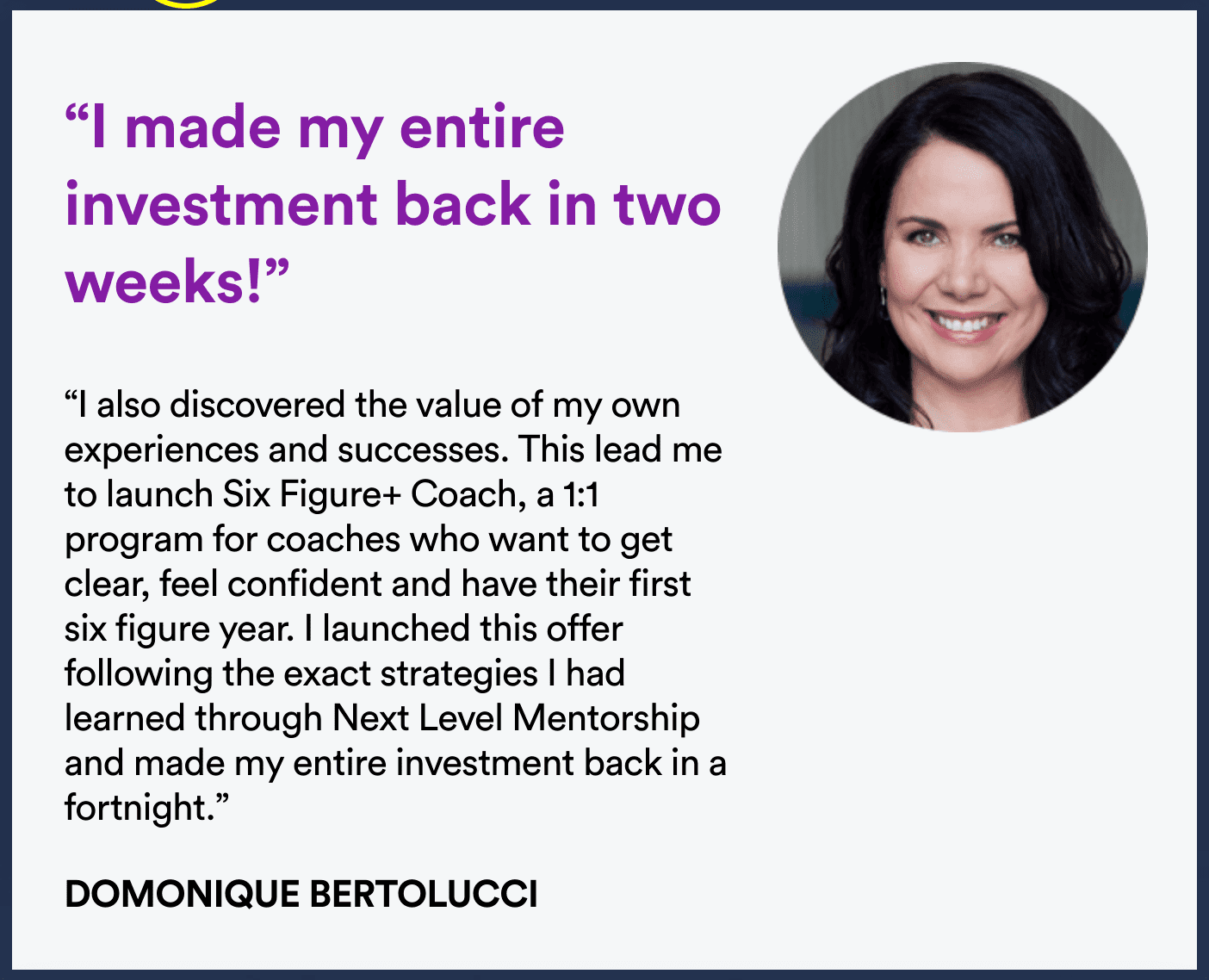
Full name and photo? Check. Clear, purposeful, positive, and focused? Definitely.
Here’s another good testimonial example (from Ahrefs’ newly-revamped homepage):

Both of these great testimonials nail the basics.
Yours should too.
Tip #2. Be Specific With Details
Words and phrases like “way up” and “it was good” are ambiguous and can mean anything.
Did an article get over 10,000 tweets and LinkedIn shares on social media? Did revenue increase by 30%?
Don’t be vague — if it’s so, say so. Testimonials with statistics are excellent social proof.
But keep in mind:
Statistics aren’t the only way to add details to a testimonial.
In fact, sometimes, you’ll be in situations where specific figures or numbers can’t be shared. In those instances, explain the details of the problem, concerns that existed beforehand, or share pertinent background info that paints a compelling before-and-after picture.
Details In Practice
Let’s compare two testimonials I’ve received:
“Nyaima was pleasant to work with. I would work with her again.”
That’s nice, but does this testimonial really tell you anything? Not really. Compare it to this one:
“Nyaima was not only easy to work with, but her communication was also excellent. She met every deadline, and also offered sound suggestions that added to the quality of each of our projects. Because of this, we were able to complete a project that generally takes six weeks in only four weeks.”
The details in this testimonial example help you envision what it’s like to work with me. A potential client thinking about hiring me doesn’t have to guess how this other client benefited.
Tip #3. Pull on the Heartstrings
A heartfelt story can move even the most cold-hearted person.
Remember your favorite comic or fairy tale from your childhood, like Batman or Snow White and the Seven Dwarfs?
Each sentence reeled you in, line-by-line with powerful words and sensory details. You could relate to Batman losing his parents or the horrific treatment of Snow White, and you wanted to know how those situations would end.
There’s a reason for this — psychologist Lani Peterson says people are wired to pay attention to narratives and stories.
Translation? Telling a good story — one that weaves in narrative elements that sparks emotion within the reader, making them want to keep reading and take action — is a great way to craft a persuasive testimonial readers can relate to.
When your prospect relates to your customer testimonials, they take a step closer to working with you. They think, “wow, I have the same problem, maybe they can help me too” or “I am stuck at the same place, maybe working with this person will give me similar results.”
And one of the best ways to capture genuine emotion and story elements is using a video testimonials. When done well, a video testimonial instantly build trust with potential clients.
Storytelling In Practice
Airbnb rocks storytelling in their series featuring Airbnb hosts. They successfully display the humanity of hosts that prospects can relate to:
Here is another masterful demonstration by Intel:
The story is so rich, you can barely tell it’s a customer testimonial.
Tip #4. Be Authentic (But Don’t be Boring)
Have you ever read a college dissertation?
No offense to the hard-working women and men who pour countless hours into them, but they are not my first choice to read. They’re dry, clinical, and cerebral — all the things you don’t want your testimonial to be.
Boring testimonials will put your prospects to sleep. And prospects who are asleep can’t take action.
But it’s not enough to simply not be boring. A powerful testimonial needs to be truthful and authentic too.
That means being genuine, sounding natural, and using conversational words. Your goal is to spark internal conversation within the reader. And to do that, every word in a testimonial must be true — a potential customer will sniff a fake testimonial from a mile away!
Remember, when someone reads a customer or client testimonial you want them to relate, they should say, “Man, he or she sounds just like me.”
That’s why slang works and stringent grammatical rules don’t have to be followed. As long as the point can be understood and it is not an unintentional typo, leave it alone. The flaw adds realness.
(Still, a quick run through a grammar checker never hurts 🙂 ).
Authenticity In Practice
Here’s an effective testimonial that Smart Blogger’s Kevin J. Duncan gave to Henneke Duistermaat for her copywriting course:
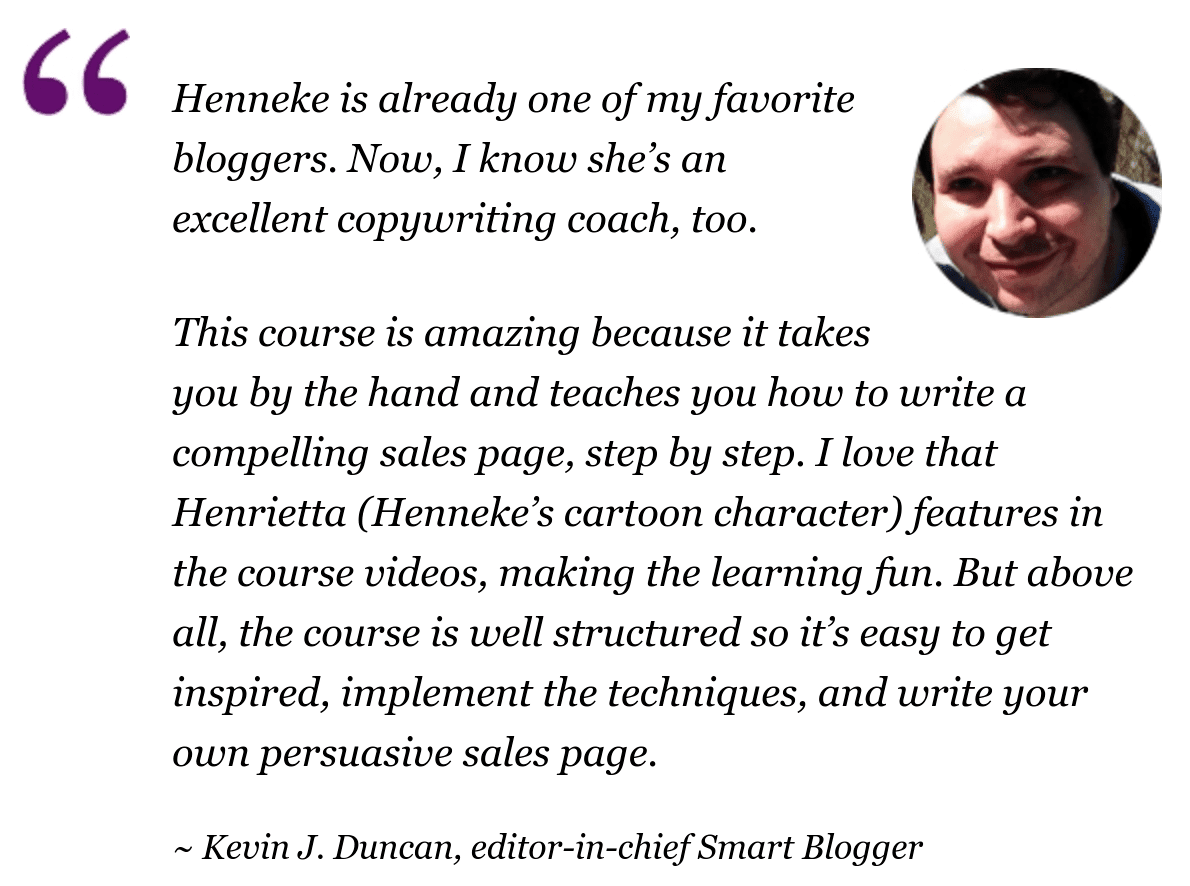
From his personal testimonial, you can (accurately) surmise that Kevin has probably known Henneke for a while, which makes his words feel genuine.
Tip #5. Use the Right Testimonial, at the Right Time, in the Right Place
There are several types of testimonials, but I’m going to focus on the big three:
- Persuasive Testimonials. These demonstrate the impact the service had on the client or customer.
- Overcome Objections. These are testimonials that speak directly to common objections and diffuse them.
- Success Stories. Such as a case study where people share positive outcomes and happy endings.
Though they share the common goal of reducing resistance, each type of testimonial is most effective in different circumstances.
The Right Time
If you want to defeat objections, implement testimonials that address potential resistance on your sales page.
If a prospect sees another customer had similar concerns that were overcome, it will boost their confidence that moving forward with you is a good choice.
The Right Place
Avoid using old-school testimonial page.
Most people only scan websites, and few visitors make it to a testimonials page. This is why you want compelling testimonials sprinkled throughout your site to solidify your marketing messages.
Best placement:
- Homepage
- Product page (think of Amazon)
- Sales and landing pages
- Most popular page of your site (other than your homepage)
- Inside emails, newsletters, print materials, and blog posts
Right Time, Right Place In Practice
Ramit Sethi, best-selling author and creator of I Will Teach You To Be Rich, is a master at strategic placement and timing. Check out how he addresses potential objections using testimonials in his email sales sequence:
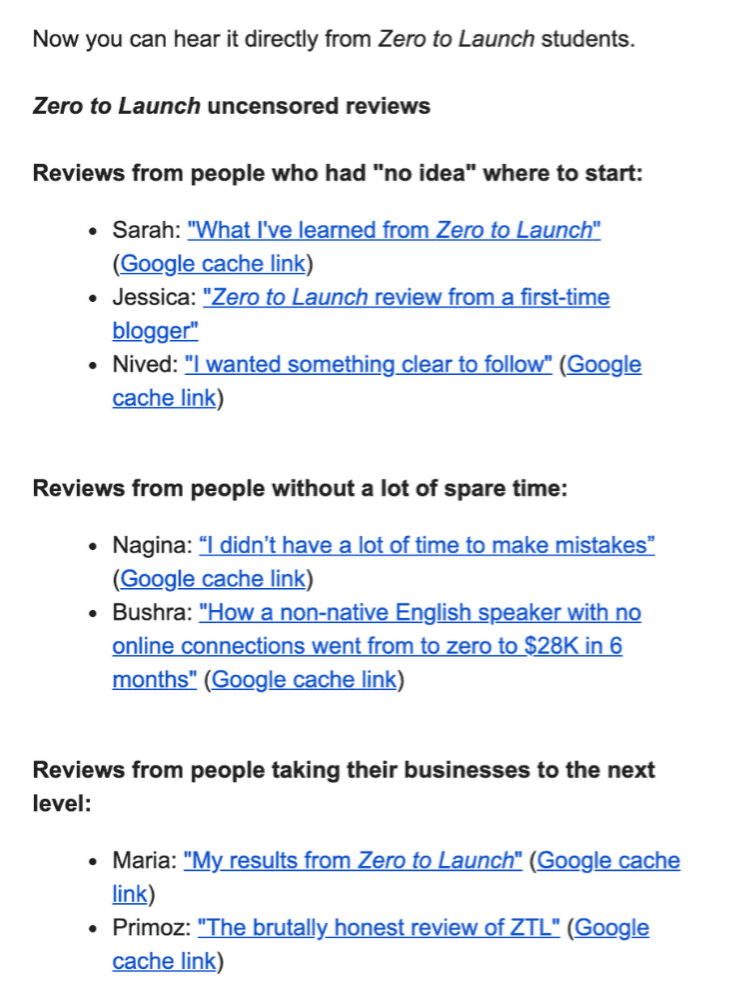
By implementing the right timing and placement, you seem like a mind-reader, answering the questions and objections of your prospects, moving them one step further in your sales process.
Tip #6. The Art of the Ask: Perfecting Your Testimonial Request
Knowing the structure and components of a good testimonial is fantastic, but it won’t matter if you don’t have any testimonials to share.
Testimonials don’t automatically come unless you ask for them or put a system in place to keep them rolling in.
Similar to sales, people get timid when it comes to asking for testimonials. They feel like they are being a nuisance. But when you deliver superb services to a happy customer, this is a small ask.
Why not remove all friction points and make it easy for you and them?
Ramit does a good job minimizing pressure by providing a template when he asks someone for a testimonial. He understands that even though a satisfied customer wants to help, they are busy, and may be plagued by blank screen syndrome. A plug-and-play testimonial template remedies that.
Another option is to simply write a short testimonial yourself and ask the contact to revise it, as needed.
How to Ask for Testimonials
Ramit uses the following script to request testimonials:
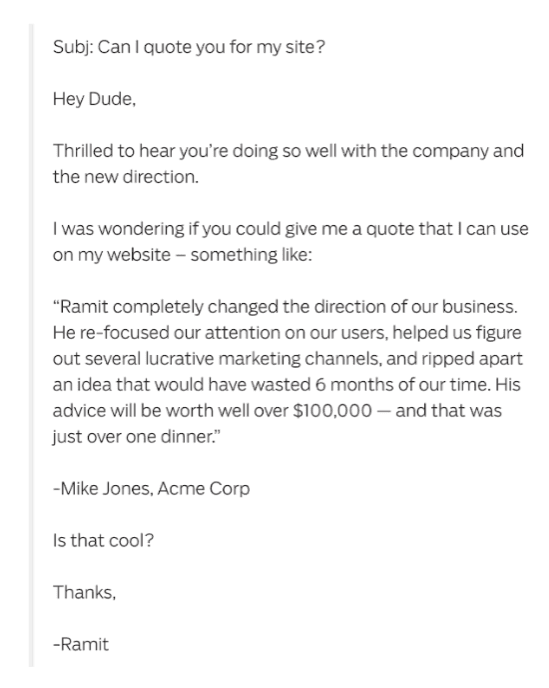
Her Business gives clients a simple plug-and-play template to complete:
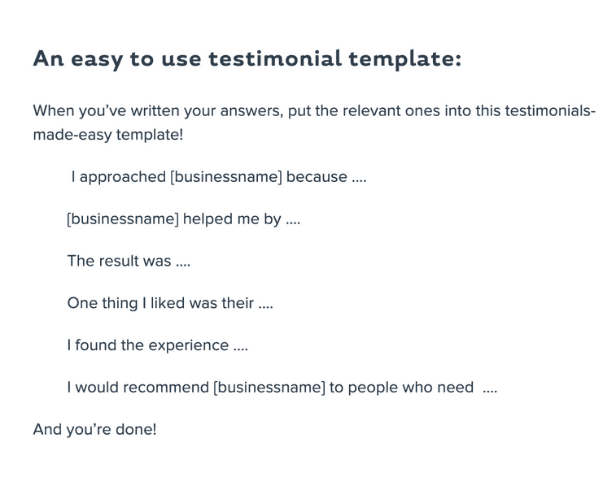
And this leads us to the final tip…
Tip #7. Automation Makes it Easy
Savvy entrepreneurs and business owners systemize and automate as much of the collection and writing of testimonials as possible.
So should you. Collecting testimonials should be embedded in your business.
For example, Marisa Murgatroyd has a system that gets her a constant flow of customer feedback — the “ask” is embedded right into the completion of her courses:
Students provide Marisa a compelling testimonial as part of their graduation process.
This process has landed her over 700 pages of testimonials that she can use in every area of her marketing, from a self-promoting blog post to a targetted ad on social media.
You don’t have to copy her exact method, of course. Every system will vary based on your particular business. The key is to take friction points away that may interfere with you getting great customer quotes and to automate as many parts of the process as possible.
You Now Know How to Write a Testimonial!
Whether you’re a brick-and-mortar business owner or a budding blogger looking to score freelance writing jobs, a well-written testimonial is a powerful tool that can boost your credibility and add some oomph to your marketing material.
In this post, you learned about the proven structure of a powerful testimonial, as well as the essential ingredients needed to turn good testimonials into great ones.
Now it’s time to put what you learned into action.
Want to build trust with your readers? Want to boost your credibility with a prospective customer or client?
Testimonials are the answer.
Go get them!






What a superb post!
Never read such an in-depth anatomy of ‘Testimonials’.
Grateful to SmartBlogger’s whole team.
Thanks Abdul! So happy you found the post valuable.
Be sure to check out other posts on SmartBlogger’s for more in-depth actionable tips…
Hey Nyaima! Terrific article and tips! I agree, asking is critical. This is part of our weekly outreach. We have been so focused on asking for headshots when asking for testimonials, we should love the idea of adding the client LOGO’s as well! And what a great branding opportunity for the customer. Thank you for including Cushing in this article!
Hey Vishal! So happy you found the tips valuable! Asking is ALWAYS key. Hope you are crushing it with your outreach!
This is fantastic! I’ve been asked to write a couple of testimonials, but I find that I tend to get wordy (a no-no!) and don’t give specifics, just superlatives. I can see that clearly now. This post gives me the exact steps I need to write a concise and convincing review, thank you!
Thanks Sandra!
It is easy to be general and use lots of fluffy superlatives. I still reference these steps when I write testimonials.
Thanks for reading. Happy testimonial writing 🙂
Nyaima,
Thanks a lot for this highly practical post!
One of the things I like about SmartBlogger is how generous you guys are towards referencing people operating in the same space.
Thanks to this post I stumbled upon Henneke, who’s blog I immediately bookmarked for an extensive weekend perusal.
Cheers!
Joost
Joost,
So happy you found this post practical!
And glad you found extra value by stumbling upon Henneke. Smartblogger is committed to promoting the best of the best to our audience.
Cheers,
Nyaima
Hey Nyaima,
I feel as Bloggers, we always forget to follow up. And it’s such a crucial step, as you pointed out.
I absolutely love both the ideas you mentioned to collect testimonials, especially the plug and play template. You’re right. It will make writing testimonials super easy for students.
Thank you for writing such an in-depth article on writing and collecting testimonials. I’m going to take action straight away by writing my follow-up email right now!
Warm regards,
Angela
Hey Angela,
Exactly! Follow-up is key, but usually a step that we forget as bloggers.
I’ve personally used the plug and play method often and finds it works well. It takes away much of the friction, especially when requesting a testimonial from a busy person.
Glad you found value!
Hello Nyaima,
Thanks for this truly informative, actionable and insightful article about the do’s and don’ts of
writing and asking for testimonials.
I never understood why anyone would write a testimonial with just a first name, and even more so why it would be accepted and published by the requester.
Glad to know that it wasn’t just me being picky.
Enjoyed the entire post!
Thanks
Hello Yvonne,
Thank you for reading! So happy you found the post informative and actionable.
LOL, it’s not just you being picky, you understand the foundation of a good testimonial.
Thanks,
Nyaima
Very interesting article, thank you for sharing it!
It has so many good and practical tips, and it is very useful to have some good example right after the explanation of each point.